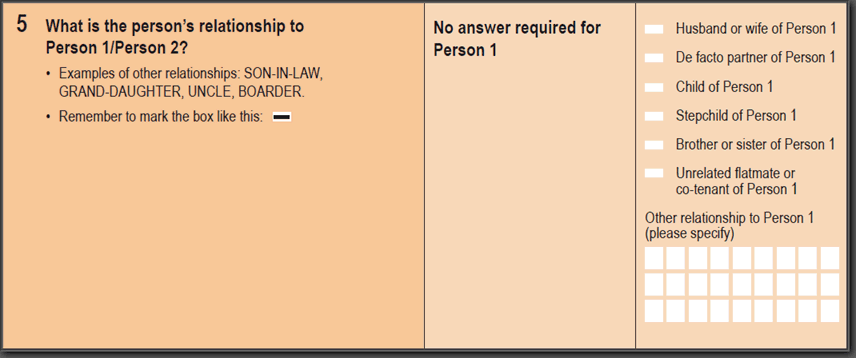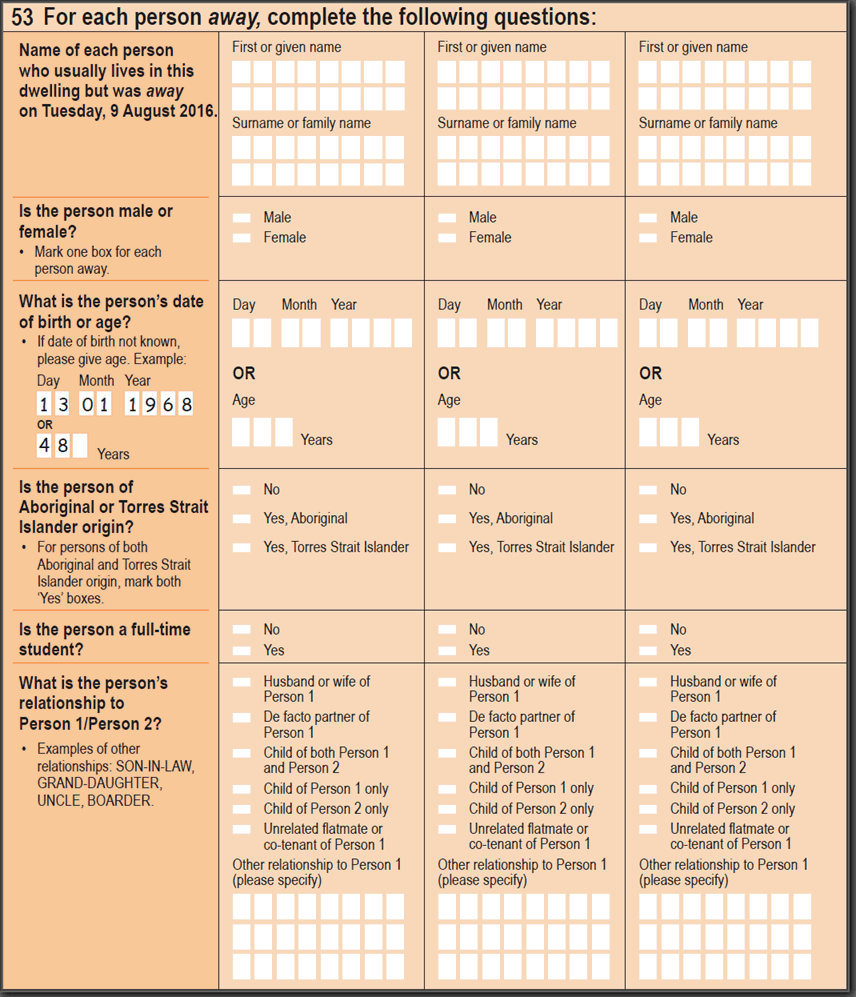Grandparent Families (FMGF)
This variable classifies families into different family structures depending on the composition of the family. It differs from the standard family composition variable in that it recognises grandparent-grandchild relationships.
This variable is applicable to all families with grandchildren.
How this variable is created
Grandparent families are derived from the Relationship in Household and Persons Temporarily Absent questions on the Census Household Form. Images of these questions are provided below. They are recognised from the Relationship in Household question where an 'Other relationship' is written in with a response indicating a grandchild relationship, such as 'granddaughter' or 'grandson'.
Grandparent families are recognised where there is a grandparent-grandchild relationship present and no parent-child relationship present in a family. This information is then combined with Family Composition data to derive Grandparent Families variable categories.
When using standard variables (see below for more information), a person who is aged 15 years or more and has the relationship of 'grandchild' is treated as an 'other relative'. If there is a sole grandparent in the family, the family is coded as an 'other family'. A grandparent couple would be coded as a 'couple family with no children and with relatives'. When using grandparent variables, this person, who is aged 15 years or more and has the relationship of 'grandchild', is treated as a type of 'child'. A sole grandparent is classified as a ‘lone parent’ and a family with a grandparent couple is classified as a 'couple family with children'. The grandchild would have a relationship of 'dependent student' or 'non-dependent child' rather than 'other relative'.
Due to these differences in definitions, the 'grandparent' variables should not used in combination with the standard variables, as this could result in misleading data.
Variable history
This variable was first introduced in 2011 to enable grandparent families to be identified more easily within the data. No changes were made in 2016.
Non-response rate
Non-response rate only applies to data items that directly reflect responses to individual Census form questions. The Grandparent Families variable does not have a non-response rate as it is a derived value created during Census processing for applicable families. For more information, refer to Understanding Census data quality.
Data usage notes
The focus of this variable is on grandparent families, and should only be used in conjunction with other related grandparent/grandchild classifications.
Variations on the composition of grandparent families can be very detailed. When requesting customised data, users should take into account whether the grandparent families of interest contain only grandchildren under 15 years of age or if they also contain dependent student grandchildren aged 15-24 and/or non-dependent grandchildren of any age. Other considerations include whether or not there are other related children in the family.
This variable is not included in standard census data products. It is available in TableBuilder Pro or through custom data requests. It can be used in combination with other person, family and dwelling variables.
Users should note that grandparent-grandchild relationships are constructed for the purposes of family coding in order to create a statistical family. It may not be representative of who provides care, for example a grandparent caring for their grandchild or vice versa.
The limited information can also result in incorrectly identifying some children as grandchildren in the family and incorrectly identifying relationships as grandparent-grandchild relationships. For example, if a parent is temporarily absent from the family and their relationship reported does not confirm their relationship to their child, that parent-child relationship cannot be coded. This can result in a small number of children being reported as grandchildren when a parent is simply absent on Census night.
Further information
A definition for Grandparent Families is available in the 2016 Census Dictionary with additional information available in the Glossary.
For information related to Grandparent Families, see data quality statements for related information for Child Type, see data quality statements Child Type and Family Composition.
Household form question image
Questions 5 and 53 as they appear on the 2016 Census Household Paper Form:


A text only version of the online Census Household form is available from the Downloads tab.
 Print Page
Print Page
 Print All
Print All